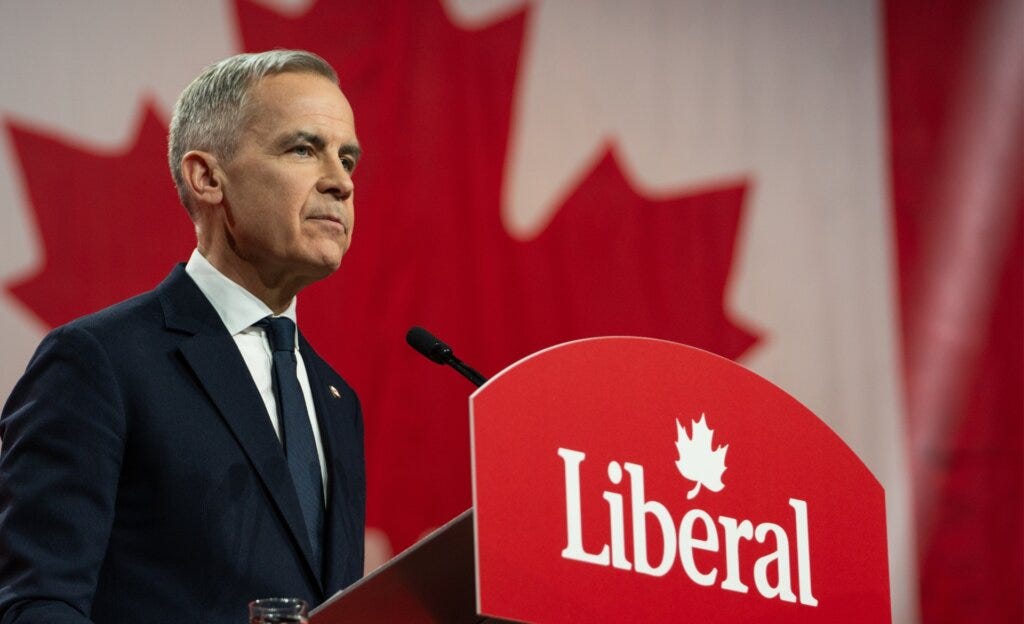What Mark Carney’s Liberal Party Win Means for Canadian Immigration
A win for families, continued uncertainty for international students, and possible escalation of federal-provincial tensions.
Please forward this to ONE friend today and tell them to subscribe here.
The ballots are in, and Mark Carney is the new Canadian Prime Minister. The Liberal Party winning Canada’s 2025 federal elections means we swapped faces and not parties, but the election result gives Ottawa’s existing 2025-27 Immigration Levels Plan political legitimacy. Rachel Bendayan, Minister of Immigration, and Immigration, Refugees, and Citizenship Canada (IRCC) can begin operationalizing Carney’s campaign pledges into regulatory changes in the coming weeks.
But What Did Carney Promise?
Carney’s immigration policy aimed to keep permanent resident admissions below 1% of Canada’s population and reduce temporary residents to below 5% by the end of 2027.
These targets will guide most of the Liberals’ immigration policy decisions in the coming years, which include:
Permanent-resident levels: Annual PR intake below 1% of Canada’s population “beyond 2027,” starting with targets of 395,000 (2025), 380,000 (2026), and 365,000 (2027).
Temporary residents: Reduce from 7.2% to under 5% of the population by 2027, maintaining the student-permit cap and stricter temporary foreign workers rules.
Housing: Keep immigration caps until the government expands housing and reabsorbs pandemic-era growth.
Francophone immigration: Raise Francophone intake outside Quebec to 12% by 2029.
Credential recognition: Work with provinces to improve recognition of foreign credentials and experience through a “national credentials passport.”
Family reunification: Cut sponsorship processing to under 12 months; issue temporary visas for spouses/children to live in Canada while waiting.
Asylum & border: Increase legal-aid funding for claimants; faster removals after due process; more CBSA resources and stricter visa screening.
Who are the Winners and Losers in the Near Term?
Families win. The immediate winners might be families separated by immigration backlogs. The Liberals promised to process spousal and child reunification applications within 12 months. Most importantly, to issue temporary visas allowing family members to live in Canada during processing.
Uncertainty continues for international students. Canada’s international student sector, overly dependent on foreign tuition, faces restrictions. Carney intends to maintain the 35% reduction in study permits introduced in January 2024 by Trudeau’s administration.
Things feel so-so for employers. According to RBC Economics, Canada loses C$50 billion in GDP annually due to the immigrant wage gap. Meanwhile, businesses report losing C$38 billion a year from workforce shortages. Carney pledged to speed up foreign credential recognition through the national credentials passport system and improve the Global Skills Strategy program so employers can attract international talent through fast-track work permit processing. But the reduction in temporary foreign workers means worsening labor shortages, particularly in healthcare and construction.
Tighter federal caps mean possible federal-provincial tensions. Western and Atlantic Canada (Alberta, Manitoba, British Columbia, Yukon Territory, Northwest Territories, Saskatchewan, Newfoundland and Labrador, Prince Edward Island, Nova Scotia, New Brunswick) rely on international students and the Provincial Nominee Programs (PNP) to address labor needs and drive population growth. Tensions will likely escalate as they struggle to work within steep federal caps.
What Do These Changes Mean for Canada?
For over a decade, immigration has been Canada’s primary growth strategy. But even Carney agrees the previous government’s immigration policies allowed levels to rise at an “unsustainable” pace. The backlash has seen anti-immigrant sentiment rise to a 30-year high.
Carney’s approach hopefully tempers these tensions: Growth must be sustainable. Housing must catch up. And communities must integrate newcomers seamlessly.
In the short term, immigrants hoping to move to Canada now face tighter caps and more selective processes. But the long-term consequences could be slower population growth, a declining reputation as a welcoming country, and increased competition for skilled immigrants from other countries.
7 Questions I Hope to Explore on The Newcomers Podcast in the Coming Months
What could hinder the government’s immigration objectives?
What do the Liberals need to address to fulfill their immigration promises?
Can Canada build enough housing to justify loosening caps after 2027?
Will provincial governments cooperate with federal targets, or oppose them?
Can credential recognition reforms help skilled immigrants enter the workforce more quickly?
Can Canada maintain its economic growth with an aging population, lower birth rate, and fewer newcomers?
What’s the government’s plan for business immigration? It’s barely gotten a mention in the buildup to the election but it’s a reliable way to stimulate economic growth and employment.





